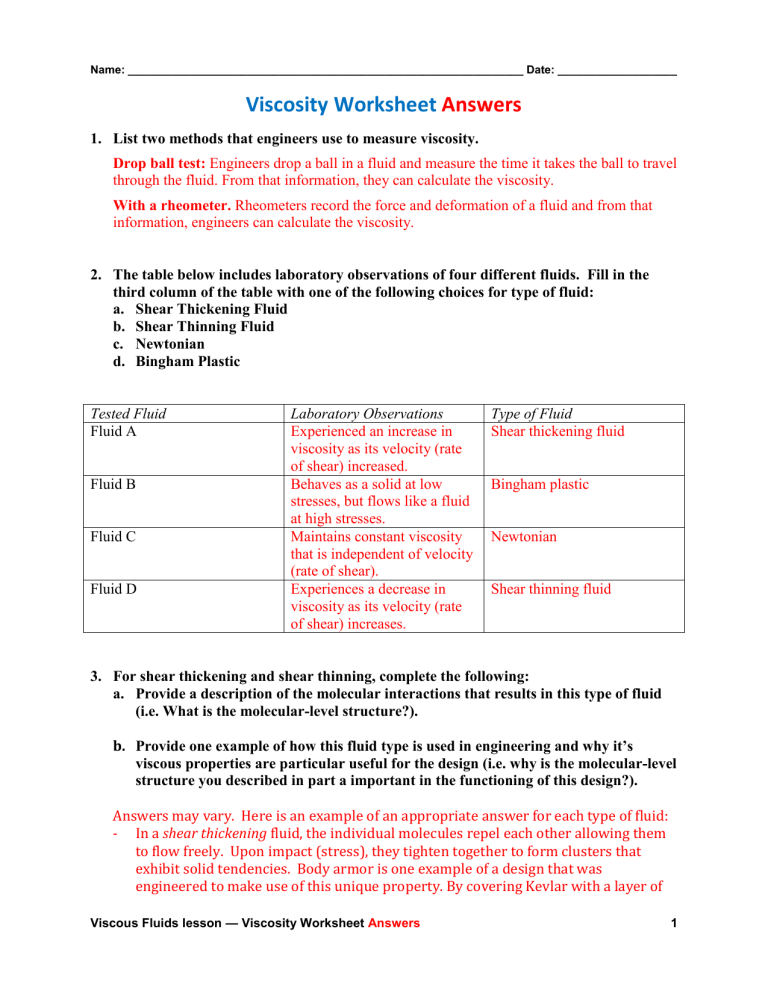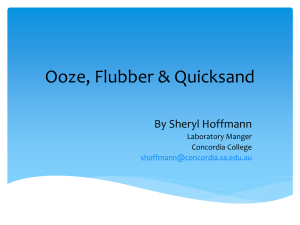Viscosity Worksheet Answers

Name: _______________________________________________________________ Date: ___________________
Viscosity Worksheet Answers
1.
List two methods that engineers use to measure viscosity.
Drop ball test: Engineers drop a ball in a fluid and measure the time it takes the ball to travel through the fluid. From that information, they can calculate the viscosity.
With a rheometer.
Rheometers record the force and deformation of a fluid and from that information, engineers can calculate the viscosity.
2.
The table below includes laboratory observations of four different fluids. Fill in the third column of the table with one of the following choices for type of fluid: a.
Shear Thickening Fluid b.
Shear Thinning Fluid c.
Newtonian d.
Bingham Plastic
Tested Fluid Laboratory Observations Type of Fluid
Fluid A Shear thickening fluid
Fluid B
Fluid C
Fluid D
Experienced an increase in viscosity as its velocity (rate of shear) increased.
Behaves as a solid at low stresses, but flows like a fluid at high stresses.
Maintains constant viscosity that is independent of velocity
(rate of shear).
Experiences a decrease in viscosity as its velocity (rate of shear) increases.
Bingham plastic
Newtonian
Shear thinning fluid
3.
For shear thickening and shear thinning, complete the following: a.
Provide a description of the molecular interactions that results in this type of fluid
(i.e. What is the molecular-level structure?). b.
Provide one example of how this fluid type is used in engineering and why it’s viscous properties are particular useful for the design (i.e. why is the molecular-level structure you described in part a important in the functioning of this design?).
Answers may vary. Here is an example of an appropriate answer for each type of fluid:
In a shear thickening fluid, the individual molecules repel each other allowing them to flow freely. Upon impact (stress), they tighten together to form clusters that exhibit solid tendencies. Body armor is one example of a design that was engineered to make use of this unique property. By covering Kevlar with a layer of
Viscous Fluids lesson — Viscosity Worksheet Answers 1
Name: _______________________________________________________________ Date: ___________________ shear thickening fluid, it better protects the body from fast-moving threats, like bullets or shrapnel.
In a shear thinning fluid, as the molecules rub past each other, the viscosity lowers and the substance flows. Whipped cream, motor oil, and paint are all examples of shear thinning fluids. Imagine if motor oil was shear thickening? That would be bad! Instead, as motor oil flows through an engine, it thins keeping it easy to move and lubricate the engine instead of thickening and clogging.
4.
Describe how the following two equations are similar: t = m du dy
÷ s =
E e
In each equation, the stress in the material (caused by a force on the material) is equal to a material property (Young’s modulus or viscosity) multiplied by either the strain or velocity of the material, which tells something about the response of the material to the force (either moving the material or deforming it). Therefore, the Young’s modulus and viscosity are similar in that they measure a material’s resistance to deformation (or movement).
5.
Label on the following graph which response is due to a fluid that has Newtonian, shear thinning, shear thickening and Bingham plastic behavior.
Viscous Fluids lesson — Viscosity Worksheet Answers 2
Name: _______________________________________________________________ Date: ___________________
6.
Research online examples of fluids that are shear thinning and shear thickening. Give an example of each type of fluid (shear thinning and shear thickening) and describe how engineers have used the properties of that fluid to their advantage.
Shear thinning: One example of a shear thinning fluid is paint. Engineers have used the shear thinning properties of paint to their advantage because it easily adheres on a roller due to the increase in velocity the roller imposes on the fluid. When the paint is applied to the wall and the force on the fluid is reduced, the viscosity increases to its original state and the paint stays on the wall without dripping. Other examples: whipped cream, ketchup, blood, motor oil.
Shear thickening: One example of shear thickening fluids being used in devices designed by engineers is body armor. The fluid in body armor reacts to sudden forces (increase in velocity) like a bullet and immediately increases its viscosity, which in turn stops the bullet.
The combination of Kevlar and a shear thickening fluid performs better at protecting than
Kevlar alone. The fluid-Kevlar combination body armor is also one-third of the thickness of body armor containing only Kevlar, so it is more lightweight and comfortable to wear. Other examples: the fluid in vehicle traction control systems, cornstarch and water solution.
Many more examples can be found online. For more information, see the Lesson Background and Concepts for Teachers > Fluid Behavior section of the Viscous Fluids lesson.
Viscous Fluids lesson — Viscosity Worksheet Answers 3





